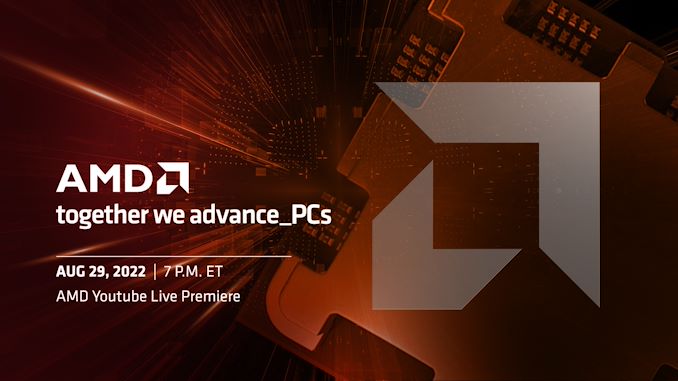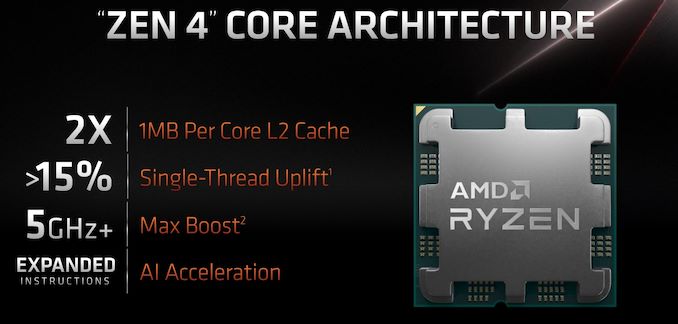AMD Announces Ryzen 7000 Reveal Livestream for August 29th
by Ryan Smith on August 16, 2022 2:25 PM EST- Posted in
- CPUs
- AMD
- Zen 4
- AM5
- Ryzen 7000

In a brief press release sent out this morning, AMD has announced that they will be delivering their eagerly anticipated Ryzen 7000 unveiling later this month as a live stream. In an event dubbed “together we advance_PCs”, AMD will be discussing the forthcoming Ryzen 7000 series processors as well as the underlying Zen 4 architecture and associated AM5 platform – laying the groundwork ahead of AMD’s planned fall launch for the Ryzen 7000 platform. The event is set to kick off on August 29th at 7pm ET (23:00 UTC), with CEO Dr. Lisa Su and CTO Mark Papermaster slated to present.
AMD first unveiled their Ryzen 7000 platform and branding back at Computex 2022, offering quite a few high-level details on the forthcoming consumer processor platform while stating it would be launching in the fall. The new CPU family will feature up to 16 Zen 4 cores using TSMC's optimized 5 nm manufacturing process for the Core Complex Die (CCD), and TSMC’s 6nm process for the I/O Die (IOD). AMD has not disclosed a great deal about the Zen 4 architecture itself, though their Computex presentation has indicated we should expect a several percent increase in IPC, along with a further several percent increase in peak clockspeeds, allowing for a 15%+ increase in single-threaded performance.
The Ryzen 7000 series is also notable for being the first of AMD’s chiplet-based CPUs to integrate a GPU – in this case embedding it in the IOD. The modest GPU allows for AMD’s CPUs to supply their own graphics, eliminating the need for a discrete GPU just to boot a system while, we expect, providing enough performance for basic desktop work.
| AMD Desktop CPU Generations | |||
| AnandTech | Ryzen 7000 (Raphael) |
Ryzen 5000 (Vermeer) |
Ryzen 3000 (Matisse) |
| CPU Architecture | Zen 4 | Zen 3 | Zen 2 |
| CPU Cores | Up To 16C / 32T | Up To 16C / 32T | Up To 16C / 32T |
| GPU Architecture | RDNA2 | N/A | N/A |
| GPU Cores | TBD | N/A | N/A |
| Memory | DDR5 | DDR4 | DDR4 |
| Platform | AM5 | AM4 | AM4 |
| CPU PCIe Lanes | 24x PCIe 5.0 | 24x PCIe 4.0 | 24x PCIe 4.0 |
| Manufacturing Process | CCD: TSMC N5 IOD: TSMC N6 |
CCD: TSMC N7 IOD: GloFo 12nm |
CCD: TSMC N7 IOD: GloFo 12nm |
The new CPU family will also come with a new socket and motherboard platform, which AMD is dubbing AM5. The first significant socket update for AMD in six years will bring with it a slew of changes and new features, including a switch to an LGA-style socket (LGA1718) and support for DDR5 memory. Providing the back-end for AM5 will be AMD’s 600 series chipsets, with AMD set to release both enthusiast and mainstream chipsets. PCIe 5.0 will also be supported by the platform, but in the interest of keeping motherboard prices in check, it is not a mandatory motherboard feature.
The remaining major disclosures that AMD hasn’t made – and which we’re expecting to see at their next event – will be around the Zen 4 architecture itself, as well as information on specific Ryzen 7000 SKUs. Pricing information is likely not in the cards (the industry has developed a strong tendency to announce prices at the last minute), but at the very least we should have an idea of how many cores to expect on the various SKUs, as well as where the official TDPs will land in this generation given AM5’s greater power limits.
Meanwhile, AMD’s press release does not mention whether the presentation will be recorded or live. Like most tech companies, AMD switched to pre-recorded presentations due to the outbreak of COVID-19, which in turn has been paying dividends in the form of breezier and more focused presentations with higher production values. While relatively insignificant in the big picture of things, it will be interesting to see whether AMD is going back to live presentations for consumer product unveils such as this.
In any case, we’ll find out more during AMD’s broadcast. The presentation is slated to air on August 29th at 7pm Eastern, on AMD’s YouTube channel. And of course, be sure to check out AnandTech for a full rundown and analysis of AMD’s announcements.
Source: AMD











52 Comments
View All Comments
ballsystemlord - Tuesday, August 16, 2022 - link
I'd also like to see more PCIe ports.meacupla - Wednesday, August 17, 2022 - link
did you mean PCIe lanes?24x PCIe 5.0 lanes is equivalent bandwidth to 48x PCIe 4.0 lanes
That's enough to run two 5.0 NVMe SSDs, and two GPUs, and running 2x GPUs is a dead feature anyways.
lilkwarrior - Wednesday, August 17, 2022 - link
Running 2x GPUs is extremely common for productive computer users, especially high-end Ryzen/Intel CPUs and the respective motherboards.Even Apple unapologetically supports mGPU rendering out of common sense. It's game developers who haven't emphasized it; in turn pure gamers haven't had an incentive to care but that audience likes to talk as though high-end computing hardware is primarily for them when most of that audience can hardly comfortably afford or go above entry-level motherboards and CPUs.
12VHPWR standard is specifically designed to enable single GPU–especially dual GPU die ones–the power to replace two GPUs with one + one cable to connect them. This allows four-way mGPU rendering to be replaced by two GPUs and so on.
This is common knowledge in the AI and creative professional industries .
meacupla - Wednesday, August 17, 2022 - link
okay, but 24 lanes of PCIe 5.0 has the bandwidth for that, so the problem is what?schujj07 - Wednesday, August 17, 2022 - link
Unless you have a PCIe switch the added bandwidth won't allow you to turn 24x PCIe 5 lanes into 48x PCIe 4 lanes.Threska - Wednesday, August 17, 2022 - link
"This is common knowledge in the AI and creative professional industries ."That's about the only two, since the current setup is dealing with transient and bulk power issues.
ballsystemlord - Wednesday, August 17, 2022 - link
No, PCIe ports.abufrejoval - Wednesday, August 17, 2022 - link
That touches on something completely unclear to me so far: can PCIe switches actually translate/manage the trade-off between PCIe generations and lanes?I'm not sure how much PCIe is packet based or connection based: it seems to have elments of both.
But say you have a NIC that uses 4 lanes of PCIe 2.0 to deliver 10Gbit/s Etherent: could a PCIe switch chip translate that to a single PCIe 4.0 lane, which evidently provides the bandwidth (and vice-versa)? I naturally assumed it could (network mentality, I guess), but currently I'm very much in doubt.
Obviously going backward from PCIe 5.0 all the way to PCIe 1.0 is no issue, nor is using fewer lanes than a slot might provide. But can "store-and-forward" switches translate/trade between versions and lanes?
And yeah, GPUs aren't just used for games. Some are still used for mining and evidently in that context the CPU/GPU bandwidth is of no matter, which is why they often operate only with a single PCIe lane for the transfer of metadata.
And also yes, I've been sticking two V100 into a few servers for machine learning purposes, where the halving the bandwidth between CPU/GPU didn't make things much worse already, because you'd better make sure to fit your models inside the GPU memory anyway: host RAM is the new type in machine learning...
DanaGoyette - Wednesday, August 17, 2022 - link
Since the link between chipset and SOC is just PCIe anyway, I'd love to see them make add-in PCIe cards with those chips on them, exposing most of the useful IO of the chipset. Imagine if you could get a bunch of SATA ports, and the 10Gbe MAC if it even still exists, all on one card...spaceship9876 - Tuesday, August 16, 2022 - link
Do we know whether this comes with built-in 2.5gbps ethernet support like intel's latest chips?